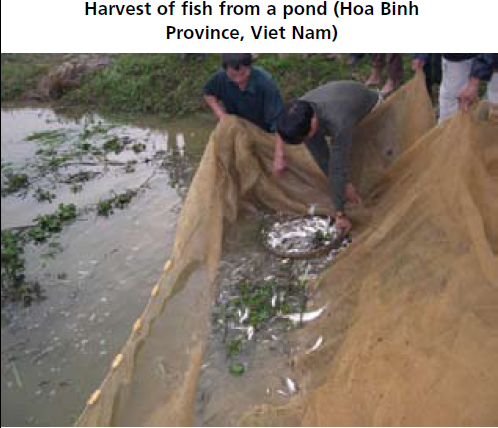Low Technology Application:
Low-tech aquaponics involve the simultaneous cultivation of an aquatic species and plants in a system. There is a reduced need for fertilizer because the waste of the aquatic organisms are used by the plants as nutrients. This type of aquaponics has been historically implemented for thousand of years in China and other places that have large swampy tracts of land. The most commonly implemented one is a Tilapia-Azolla-Rice culture. Tilapia are one of the most efficient species of fish and can put on close to one pound of fish flesh per pound of fish food they eat; the Azolla is a floating aquatic macrophyte that acts as supplemental food to the fish. The rice can be harvested directly for human consumption. This solution requires investment in education; training the local farmers is the key to its successful implementation. The method holds particular promise where conventional agriculture is not viable due to the excess of swampland and lack of soil.

Source: M.G.Kibria, http://www.fao.org/docrep/012/i1141e/i1141e02.pdf
High Technology Application:
Aquaponics eliminates the need for expensive fertilizers while reducing the environmental impact of growing fish, as the plants naturally filter the water as they take in nutrients (Luke's Mission Aquaponics, n.d.). In addition, growing fish using aquaponic systems requires less water and land than traditional methods of production.This solution will provide malnourished people with a source of protein, a nutrient that is crucially important for maintaining a healthy body, but is often unavailable to people in impoverished areas ("World Hunger Education," n.d.).
Source: Sadidov, 2004, http://www.dfo-mpo.gc.ca/science/enviro/aquaculture/acrdp-pcrda/projects/reports...
Above is a schematic depicting the basic components required for a successful aquaponics system. Fish effluent is first transferred to clarifiers before passing through filter tanks containing nitrifying and ammonifying bacteria that mineralize the waste. The filtered waste is then used on the plants as fertilizer. By the time the water has circulated through the plant growing troughs, it will be completely filtered and ready for transfer back to the fish tanks. This system can be adapted for large-scale farming as well as small-scale farming. However, the technology is still very much in development.
A model based on the experimental aquaponics site at the University of Virgin Islands may be adapted for use in areas where water and land are scarce. The UVI aquaponic system covers a total land area of only 0.05 ha. Between 2002 and 2004, UVI experimented with various food crops, including okra and basil. The highest annual yields for basil and okra were 25 kg/m^3 and 13.37 kg/m^3, yields much greater than those from traditional field production (Rakocy, Bailey, Shultz, & Thoman, n.d.). More importantly, the annual average production of fish was 4.16 mt for Nile tilapia and 4.78 mt for red tilapia between 2002 and 2004. This amounts to approximately 214, 4 ounce servings of fish per year("Fish, Tilapia, Cooked,," n.d.).Each serving of tilapia produced provides around 100 calories and over 50% of the daily value of protein recommended by the World Food Program. ("Protein," n.d.). Thus, this technology can be especially effective in combating hunger and protein deficiency, the most dangerous form of malnutrition (World Hunger and Poverty, 2010).
In order to successfully implement this solution in developing countries, a sufficient electronic infrastructure must be in operation. Growing fish using aquaponics is less costly than growing fish using monoculture due to the reduced cost of filtration infrastructure and management personnel (Graber & Todt, 2002). However, the system must be carefully maintained to produce a good harvest. Although this can be done manually, it is much easier to continuously monitor parameters such as water temperature, oxygen levels, or pH levels with an electronic system. Electricity is also required for the sump pump and for the control of water flow in and out of the various system components. Once this complication has been resolved, the construction of the actual system is fairly easy, requiring commonplace materials and minimal labor. Finally, before the aquaponics system can be implemented, persons must be trained to plant, harvest, and properly maintain the system.
Aquaponic systems do not require a lot of time to implement if the system is designed properly beforehand. The system at UVI, for example, started development in the late 1990s and was successful by the beginning of the 2000s after the major design problems were ironed out. We expect most of the aquaponic systems to be operating at full capacity within the first 10 years.
Fish, tilapia, cooked, dry heat. (n.d.). Nutrition facts. Retrieved November 29, 2010 from http://nutritiondata.self.com/facts/finfish-and-shellfish-products/9244/2
Graber, A., & Todt, D. (2002, September). Economic and ecologic potential of polyculture systems in greenhouse cultures. Retrieved November 29, 2010, from http://www.hortikultur.ch/pub/files/155.pdf
Luke's mission aquaponics project. (n.d.). Retrieved November 29, 2010, from http://www.lyontechnologies.com/aqua/whataqua.html
World Food Programme. (n.d.). Food nutritional quality: Macronutrients. Retrieved November 29, 2010, from World Food Program website: http://foodquality.wfp.org/FoodNutritionalQuality/Macronutrients/tabid/115/Default.aspx?PageContentMode=1#131
Rakocy, J. E., Bailey, D. S., Shultz, C., & Thoman, E. S. (n.d.). Update on tilapia and vegetable production in the UVI aquaponic system. Retrieved November 29, 2010, from http://ag.arizona.edu/azaqua/ista/ista6/ista6web/pdf/676.pdf
Sadidov, N. (2004, August 17). Evaluation and development of aquaponics production and product market capabilities in Alberta. Retrieved November 29, 2010, from http://www.dfo-mpo.gc.ca/science/enviro/aquaculture/acrdp-pcrda/projects/reports-rapports/ca/CA-04-01-001.pdf
World hunger and poverty facts and statistics 2010. (2010, November 14). Retrieved November 29, 2010, from http://www.worldhunger.org/articles/Learn/world%20hunger%20facts%202002.htm